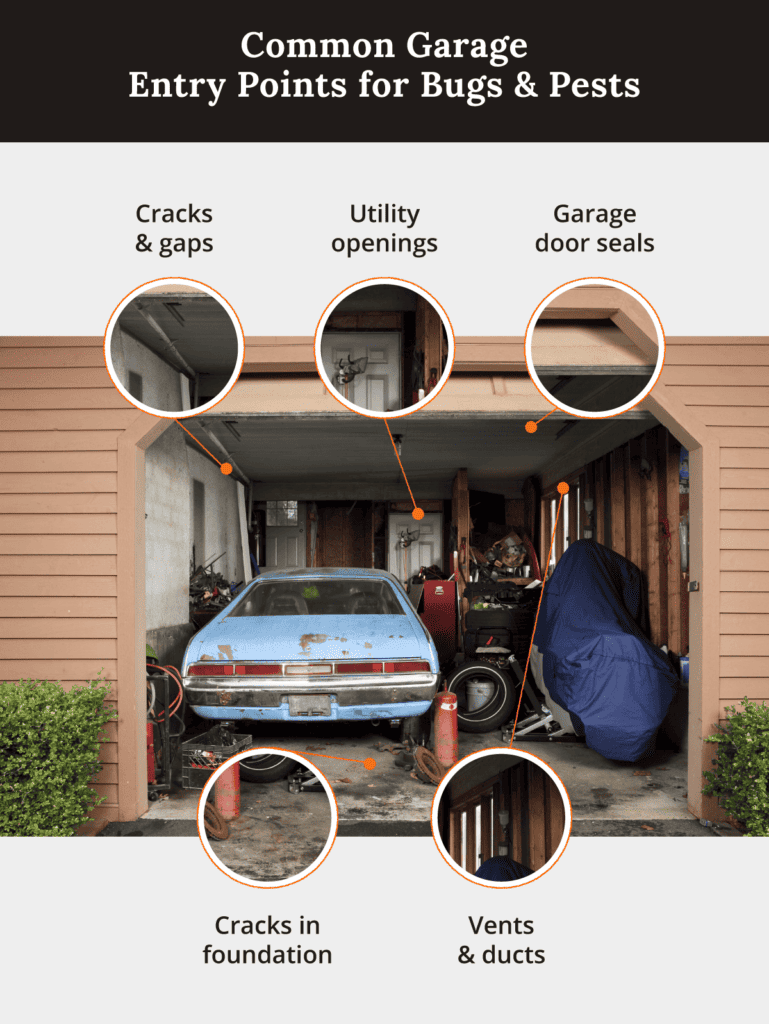Are you tired of finding bugs and spider webs in your garage? Not only are they unwelcome pests, but insect infestation can damage the structure of your garage and your items inside. Learning how to keep bugs out of the garage is key.
Why are insects and other pests so attracted to your garage? First, garages shelter bugs from harsh weather the same way they shelter your vehicles. Garages also tend to be dark and warm (similar to bugs’ natural habitats), and insects like to hide their nests safely away from predators. If you keep your garbage or food products in your garage, bugs and pests may also be attracted to the smells.
From pest recognition to choosing repellents, the following guide will help you evict bugs from your garage for good.
Types of Bugs and Pests Found in Garages

Before spraying any type of bug repellent, it’s best to figure out which bugs are most likely to infest your garage. This way, you can learn their habits and what they’re attracted to and use the right repellents and traps.
Here are the top pests to look out for in garages:
- Termites: feed on wood and all byproducts (furniture, boxes, paper products, etc.) in the home and can cause thousands of dollars in damage
- Sowbugs: love moisture and damp areas, often hiding under objects stored in the garage
- Beetles: ride on boxes and other natural materials like wood and plants brought into the garage; also active at night and tend to eat stored food products like cereal boxes and pet food
- Ants: feed on most food items and (if carpenter ants) wood, often nesting their colonies under wood
- Flies: quickly fly in through open doors or windows; attracted to odors in the garage, like garbage and plants, where they tend to lay their eggs
- Silverfish: latch onto cardboard boxes brought inside, feed on almost any object (clothes, paper, etc.); lay eggs daily and reproduce quickly
- Crickets: enter through door cracks to escape harsh weather; usually eat pet food, food crumbs, and pieces of fabric
- Spiders: like to hide in dark, cluttered corners in the garage; prey on smaller insects, and some may be venomous
- Mice: are attracted to smells and food in the garage and stay to nest in storage boxes; eat almost any type of food and also tend to chew on wiring
Bugs and other pests can carry and spread harmful bacterial diseases to humans1, so don’t hesitate to get rid of them. If you have an attached garage, pests can even make their way into your home.
How to Keep Your Garage Bug-Free
Now that you’ve identified the critters to look for, the following steps will prevent them from coming back.
1. Identify Vulnerable Areas
Knowing the common entry points for bugs, spiders, and other critters will help you stay alert. Many areas of the garage that aren’t visible or at eye level often go unchecked.

Cracks and gaps can appear in almost every area of the garage, including corners, windows, doors, walls, and the ceiling. Vents and ducts from your HVAC units are also hiding spots. Sometimes even the type of foundation you have can be the culprit, where insects such as termites eat through the wood or rodents nest in the space beneath piers.
Don’t forget about the garage door and exterior parts of the garage. Garage doors that don’t close and seal properly will leave openings for bugs to enter. Insects can also crawl inside utility openings such as pipes and cables.
2. Seal Cracks and Gaps
Use putty, caulk, and other compounds to seal all the cracks and crevices you can find. You can also use drywall patch kits to cover and close larger holes.
3. Install Bug Screens and Traps
Install screens on your garage windows, vents, and doors to create another barrier for bugs. Use adhesive traps to stop crawling insects in their tracks, and mouse traps for mice and other small rodents.
Since many bugs are drawn to lights, take advantage of your garage lighting to bait them.
4. Add Weatherstripping and Garage Door Seals
Weatherproofing all entryways in the garage will block drafts as well as bugs and spiders that come through those openings. This includes weatherstrips for entry doors and windows and garage door seals and sweeps.
Though technically not a “seal,” proper garage insulation will seal in the temperature and smells that can attract pests.
5. Ensure Proper Ventilation
Create good ventilation in the garage with fans and air conditioning to keep the humidity low. Using a dehumidifier can also help. Ventilation will make the garage comfortable for you but uncomfortable for bugs. Mesh screens create barriers at insect entry points while still allowing airflow from outside.
6. Clear Clutter and Clean Regularly
Eliminate bug hiding spots and nests by thoroughly cleaning the garage and keeping it dry. This includes sweeping or vacuuming up nests and webs and mopping up any standing water (which attracts bugs).
Remove smelly objects that attract insects, such as pet food, old clothes and furniture, and plants. If you must keep these types of items inside your garage, try
garage storage hacks like using air-sealed containers for pet food and soil mix to help conceal strong odors.
Ways to Maintain a Bug-Free Garage Long Term
After repelling pests and prepping your garage, there are additional steps you can take to keep bugs out of your garage in the future.

Regular Inspections and Maintenance
Create a schedule for regular garage maintenance, including cleaning, repairs, and periodic inspections. Doing so will help you address issues promptly, such as fixing leaky pipes and HVAC malfunctions.
Professional Pest Control
Know when to seek professional assistance. Some critters can be dangerous, such as venomous spiders or aggressive rodents. And if an insect infestation is out of control, meaning none of the DIY remedies are working, an exterminator will know what to do.
Bug Education and Awareness
Get insight from pest control professionals on how to handle bug problems based on your garage design and region. Once you have that information, you can get the entire household on board.
Natural Bug Repellents
Some common bug repellents and insecticides, such as boric acid, are harmful to humans and pets if accidentally ingested. If you want to avoid spraying chemicals, below are a few eco-friendly alternatives to try.
Essential Oils
Lavender, eucalyptus, citronella, peppermint, and cedar oil all contain compounds that are toxic to bugs. Not only do these essential oils keep bugs at bay, but they’re pleasant to smell and mask odor, which can come in handy if you use your garage space for work or leisure.
DIY Sprays
There are dozens of DIY repellent solutions you can create by combining plant extracts with water, alcohol, witch hazel, or a combination of them all. You can pour the solution into a spray bottle and lightly mist areas around the garage.
Bug-Deterring Plants
While many plants attract bugs, there are quite a few that insects hate, including marigolds, chrysanthemums, and mint. Hanging or placing these plants on shelves around your garage can double as decor.
Worry Less with an Insect-Resistant Metal Garage
Most attached garages are made of wood framing, so they can be susceptible to insect and pest infestation. Metal garages and metal buildings for sale on the other hand, are immune to damage from termites, mice, and similar pests. Combined with solid bug prevention methods, a metal garage may be a good investment.
Keep your space and items inside safe from bugs and rodents with our quality metal garages. Use our customizing tool to design and order your next prefab metal garage in minutes.
Sources:
- Center for Disease Control and Prevention. “Disease Vectors and Pests.” Accessed August 28, 2023. https://www.cdc.gov/vector-borne-diseases/index.html.




